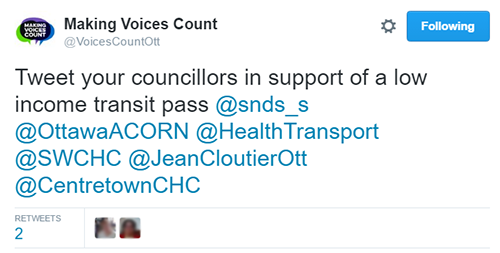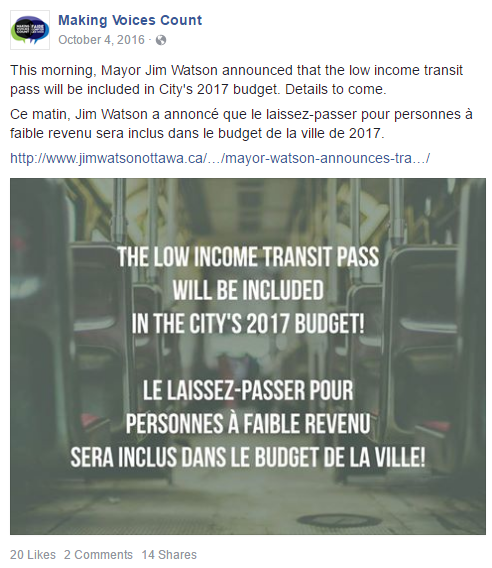Twitter can be a very useful tool. Twitter is especially helpful for reaching members of City Council and the media.
A few ways to use Twitter are as follows:
- Sign up for Twitter if you don’t have an account, it is simple and easy!
- Follow media who cover City Hall issues. Journalists attending a committee, commission or Council meeting will often live tweet what’s being said, Council member votes, etc.
- Reply to media and City Councillor tweets with your comments, concerns and praise. Correct misinformation. Open a dialogue.
- Re-tweeting can show agreement, but it does not add anything new to a conversation. Don’t just hit the re-tweet button. If you agree with a tweet and want to re-tweet, use the Quote Tweet option so you can add your opinion or experience, or more information to the conversation.
- When you want to bring an issue to the attention of the Mayor, your Councillor, or a journalist, be sure to use their handle (with the @ symbol) in your tweet.
- Use the #ottnews and/or #ottcity hashtags.
- There are 140 characters in a tweet, so use those valuable characters on hashtags that people are following (e.g. #ottawa and #ottnews)
- Hashtags are easily successful at special events and conferences, when people are motivated to use (and check!) the hashtag for a few hours or days.
- Creating a new hashtag that becomes widely used and followed for a campaign requires a lot of work. It is often best to use an existing hashtag.
Facebook Page
A Facebook Page is different than a person’s personal Facebook profile. A personal profile is almost always set-up to be private and requires that someone send you a “friend request” to see your posts. A Page is public and anyone can go to the Page and “Like” it.
Successful Facebook posts are:
- Short: Posts between 100 and 250 characters get about 60% more likes, comments and shares. People will not click the Read More link.
- Visual: Pictures, graphics and videos get more engagement. Tips: make simple graphics specifically sized for Facebook easily by using www.canva.com.
- Directed at an outcome: Encourage people to take action, for example, to call their City Councillor, attend an event, or talk to their neighbours about an issue.
- Focused and on-topic with the current strategy: For example, MVC is currently focused on the City of Ottawa budget and concerns around reductions to City services, especially cuts that could impact people living with low income. This includes the impact the City budget could have on transportation, food, employment, and more.
- Directed to a target audience: MVC keeps low-income Ottawa residents and potential (e.g. middle-class residents and community partners) informed. For example, informed about opportunities to get engaged with the budget process. MVC is helping residents understand the City Hall processes and who is involved.
- Original: Post content that followers won’t see anywhere else. For example, behind the scenes photos of participants engaged in events, at meetings, learning about City Hall, and more. MVC and the Coalition have a unique perspective. It is less interesting to share posts from news sources (e.g. CBC, CTV) that people can see elsewhere.
- Descriptive:
- Only 4% of people clink links in a post, so the post description must provide the information that someone needs to understand.
- Give context in each post description. Remember that the reader may not have as much knowledge as the person creating the post.
- Clearly explain the post so that a person who does not have any knowledge of the event, link or picture will understand and can take action.
- Answer the questions who, what, when, where, and why.
- Diverse: Write posts in multiple languages, including the top languages spoken in Ottawa: English, French, Arabic, Chinese, Spanish, Italian, Mandarin, German, Portuguese, Cantonese, Somali and Persian (Farsi).
- Special: post only when a post meets the criteria in this list. Is it better to have just one post every few days that gets responses than six posts per day that don’t get any response.
Not all of a Page’s followers see all posts. The high (or low) interaction of a Page’s followers matters because the Facebook algorithm (called EdgeRank) detects how many followers like, comment or share each post. The more (or less) a person engages with a Page’s posts, the more (or less) likely Facebook will display future Page posts in their feed. As a result, they are more (or less) likely to support your Page’s goals (e.g. volunteer, call a City Councillor, etc.).
Twitter and Facebook Content
Simply said, "content" is the information you post to your website, your blog, social media, etc. Content can be pictures, text, video, and more.
Create different content for Facebook than for Twitter. Twitter is limited to 140 characters and has its own style for hashtags and handles. Facebook allows for longer text. Plus, photos are sized differently for Facebook (940px x 788px) than for Twitter (1024px x 512px). The biggest and most noticeable problem that happens when the same photo is used on Facebook and Twitter is that people’s heads don’t appear in the Twitter picture. Use a free site like www.canva.com to easily create Facebook- or Twitter-sized graphics with text.


